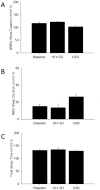Sleep active cortical neurons expressing neuronal nitric oxide synthase are active after both acute sleep deprivation and chronic sleep restriction
- PMID: 23685166
- PMCID: PMC3801181
- DOI: 10.1016/j.neuroscience.2013.05.013
Sleep active cortical neurons expressing neuronal nitric oxide synthase are active after both acute sleep deprivation and chronic sleep restriction
Abstract
Non-rapid eye movement (NREM) sleep electroencephalographic (EEG) delta power (~0.5-4 Hz), also known as slow wave activity (SWA), is typically enhanced after acute sleep deprivation (SD) but not after chronic sleep restriction (CSR). Recently, sleep-active cortical neurons expressing neuronal nitric oxide synthase (nNOS) were identified and associated with enhanced SWA after short acute bouts of SD (i.e., 6h). However, the relationship between cortical nNOS neuronal activity and SWA during CSR is unknown. We compared the activity of cortical neurons expressing nNOS (via c-Fos and nNOS immuno-reactivity, respectively) and sleep in rats in three conditions: (1) after 18-h of acute SD; (2) after five consecutive days of sleep restriction (SR) (18-h SD per day with 6h ad libitum sleep opportunity per day); (3) and time-of-day matched ad libitum sleep controls. Cortical nNOS neuronal activity was enhanced during sleep after both 18-h SD and 5 days of SR treatments compared to control treatments. SWA and NREM sleep delta energy (the product of NREM sleep duration and SWA) were positively correlated with enhanced cortical nNOS neuronal activity after 18-h SD but not 5days of SR. That neurons expressing nNOS were active after longer amounts of acute SD (18h vs. 6h reported in the literature) and were correlated with SWA further suggest that these cells might regulate SWA. However, since these neurons were active after CSR when SWA was not enhanced, these findings suggest that mechanisms downstream of their activation are altered during CSR.
Keywords: ANOVA; CSR; EEG; EMG; NREM; PBS; REM; SD; SR; SWA; ZT; analysis of variance; c-Fos; chronic sleep restriction; electroencephalogram; electromyogram; nNOS; neuronal nitric oxide synthase; non-rapid eye movement; phosphate-buffered saline; rapid eye movement; sleep deprivation; sleep restriction; slow wave activity; zeitgeber time.
Published by Elsevier Ltd.
Figures





Similar articles
-
Further characterization of sleep-active neuronal nitric oxide synthase neurons in the mouse brain.Neuroscience. 2010 Aug 11;169(1):149-57. doi: 10.1016/j.neuroscience.2010.04.066. Epub 2010 May 8. Neuroscience. 2010. PMID: 20438808 Free PMC article.
-
A role for cortical nNOS/NK1 neurons in coupling homeostatic sleep drive to EEG slow wave activity.Proc Natl Acad Sci U S A. 2013 Dec 10;110(50):20272-7. doi: 10.1073/pnas.1314762110. Epub 2013 Nov 4. Proc Natl Acad Sci U S A. 2013. PMID: 24191004 Free PMC article.
-
Behavioral sleep-wake homeostasis and EEG delta power are decoupled by chronic sleep restriction in the rat.Sleep. 2015 May 1;38(5):685-97. doi: 10.5665/sleep.4656. Sleep. 2015. PMID: 25669184 Free PMC article.
-
Sleep-active neuronal nitric oxide synthase-positive cells of the cerebral cortex: a local regulator of sleep?Curr Top Med Chem. 2011;11(19):2483-9. doi: 10.2174/156802611797470367. Curr Top Med Chem. 2011. PMID: 21906016 Free PMC article. Review.
-
Slow-Wave Activity Enhancement to Improve Cognition.Trends Neurosci. 2018 Jul;41(7):470-482. doi: 10.1016/j.tins.2018.03.003. Epub 2018 Apr 5. Trends Neurosci. 2018. PMID: 29628198 Free PMC article. Review.
Cited by
-
Chronic sleep restriction elevates brain interleukin-1 beta and tumor necrosis factor-alpha and attenuates brain-derived neurotrophic factor expression.Neurosci Lett. 2014 Sep 19;580:27-31. doi: 10.1016/j.neulet.2014.07.043. Epub 2014 Aug 2. Neurosci Lett. 2014. PMID: 25093703 Free PMC article.
-
Substance P and the neurokinin-1 receptor regulate electroencephalogram non-rapid eye movement sleep slow-wave activity locally.Neuroscience. 2015 Jan 22;284:260-272. doi: 10.1016/j.neuroscience.2014.08.062. Epub 2014 Oct 6. Neuroscience. 2015. PMID: 25301750 Free PMC article.
-
Sleep State Dependence of Optogenetically evoked Responses in Neuronal Nitric Oxide Synthase-positive Cells of the Cerebral Cortex.Neuroscience. 2018 May 21;379:189-201. doi: 10.1016/j.neuroscience.2018.02.006. Epub 2018 Feb 10. Neuroscience. 2018. PMID: 29438803 Free PMC article.
-
Neuroinflammation, Sleep, and Circadian Rhythms.Front Cell Infect Microbiol. 2022 Mar 22;12:853096. doi: 10.3389/fcimb.2022.853096. eCollection 2022. Front Cell Infect Microbiol. 2022. PMID: 35392608 Free PMC article. Review.
References
-
- Achermann P, Borbély AA. Mathematical models of sleep regulation. Front Biosci. 2003;8:S683–S693. - PubMed
-
- Barf RP, Van Dijk G, Scheurink AJ, Hoffmann K, Novati A, Hulshof HJ, Fuchs E, Meerlo P. Metabolic consequences of chronic sleep restriction in rats: changes in body weight regulation and energy expenditure. Physiol Behav. 2012;107:322–328. - PubMed
-
- Borbély AA, Achermann P. Sleep homeostasis and models of sleep regulation. In: Kryger MH, Roth T, Dement WC, editors. Principles and Practice of Sleep Medicine. 4th. Elsevier Saunders; Philadelphia: 2005. pp. 405–417.
Publication types
MeSH terms
Substances
Grants and funding
LinkOut - more resources
Full Text Sources
Other Literature Sources
Research Materials

